

Originally posted January 2, 2016
Our Gun of the Week this week is the Mosin-Nagant Model 1944 carbine, and, by extension, the entire vast Mosin-Nagant clan.

The Russian Mosin-Nagant rifle and its various descendants are interesting partly because, in official parlance, it was not actually called the Mosin-Nagant. It was originally just the "3-line Rifle, Model 1891" (a line is an antiquated Russian unit of measurement equal to one-tenth of an inch, hence, .30-caliber), and even informally it was known as the Mosin rifle in Russia.
Exactly why Western sources universally call it the Mosin-Nagant has to do with the self-promotional capabilities of one Léon Nagant, a Belgian firearms designer and industrialist, whose name will be familiar from a previous Gun of the Week. A few years after the events I'm about to summarize, Léon's brother Émile would go on to be the designer of the Nagant Model 1895 revolver, which we have already seen.
What happened was a complicated and highly political affair, but the broad strokes are these. As we have previously discussed, Russia in the late 19th century was not the most heavily industrialized country, and so the Russian military tended to source most of its equipment from foreign manufacturers. In 1889, the Russian Imperial Army held a contest for a new repeating rifle with which to replace the single-shot Berdan rifles they had been using, and which had not fared well against the repeater-armed Ottomans in the 1877-78 Russo-Ottoman War. (It took them 11 years to get around to the competition because, well, Imperial Russia.) There were three contenders. Two were submitted by Russian military officers, Captain Sergei Mosin and a chap named Zinoviev¹ (whose rifle fared so poorly in the trials that his first name is not even recorded in any of the histories I've seen); the third was offered by Léon Nagant.
The outcome of the trials threatened to become a scandal almost immediately, as the commission voted by a clear majority to adopt Nagant's rifle—and was immediately overruled by its chairman, who ordered an unscheduled new round of tests which the domestically-designed Mosin rifle proceeded to win. That would have been suspect enough, but worse was to come. One of the problems that had led Captain Mosin's rifle to lose the original vote was its habit of double-feeding (trying to load two cartridges at once, with the end result that neither one loads and the works jam up until they can be hauled open again and cleared). The Nagant rifle didn't have this problem owing to a design detail called an "interrupter", which prevented it from happening.
The commission's solution to this problem was to add Nagant's interrupter to the Mosin. This was not technically illegal, because they were the government and Russia was an autocracy, but it pissed off M. Nagant pretty thoroughly. Mosin then claimed that he had invented the interrupter, but not patented it because he was a government employee, and that Nagant had copied it from him and he was just copying it back. (Left unexplained in this scenario was why, if Mosin had invented it, he hadn't included it on his original rifle.) The revised Mosin rifle also nicked a few other details from the accepted-and-then-rejected Nagant prototype, which we'll see later on.
Nagant, furious and Belgian, promptly sued the Russian government for infringing on his patent, Mosin's claim that he had invented the thing be damned. He was also making loud public noises about never participating in a military firearms trial in Russia again, which was undesirable because he and his brother were among the leading firearms designers of their day. The Russians, on the other hand, insisted that the details of military firearms designs were state secrets, and that Nagant was liable to criminal prosecution for disclosing said details in the course of suing over them. The whole thing looked like degenerating into a noisy public pissing contest and—far worse from the Russian Army's perspective—delaying the entry of the new rifle into production.
So the Russian government did what Russian governments have always done to problems they can't simply have shot or sent to Siberia: they threw a bunch of rubles at it and made it go away. They paid Nagant the same prize Mosin had received for winning the contest (200,000 rubles), and in exchange he piped down about it.
In the Russian press, anyway. In the Belgian press, and thereby the press of more or less the entire Western world, he announced himself the new Russian army rifle's co-designer, so persistently and convincingly that those of us west of the Vistula who are interested in such things still call it the Mosin-Nagant rifle today. (At least he was humble enough to bill himself second.)
Like its two most prominent rivals and contemporaries, the Lee-{Metford|Enfield} action and the Mauser Gewehr 98, the Mosin-Nagant action debuted in a very long bolt-action infantry rifle that came along just as smokeless powder was sweeping the firearms world and went on to serve, in various guises and revisions, from the 1890s until... well, now, really, albeit not in a front-line military sense. Like them, it was the basis for the front-line Russian/Soviet infantry rifle in both World Wars. Like them, it can still be found all over the world in non-front-line applications and civilian hands alike.
The original Mosin-Nagant (we might as well go on calling it that), the Model 1891, was—technical term inbound—a long-ass rifle, with a barrel length of more than 31 inches and an overall length topping four feet. Shorter versions for mounted troops (the so-called "dragoon" model) followed almost immediately, and in 1907 these types were joined by an even shorter "carbine" model for the actual cavalry (dragoons were mounted infantry) and second-echelon troops.
In 1930, with the Soviet reorganization of Russian industry and military power well along, came a fairly major revision intended, like the English SMLE Mark III* revision some years earlier, to simplify and further standardize the rifle's production. The new infantry standard, the Model 1891/30, was shorter than the original, its length based instead on the slightly shorter but still pretty hefty dragoon version. The inevitable revision to the carbine came eight years later, for those in the Red Army who needed something a bit wieldier. (By 1930, with the cavalry thing mostly over, that meant virtually everyone who was under arms but not a front-line infantryman. Sentries, signals personnel, engineers, that kind of thing.) The Model 38 carbine was so preoccupied with compactness, in fact, that it was not only not equipped with a bayonet, but deliberately configured so that the 91/30 bayonet wouldn't fit it.
The form of the full-length Mosin-Nagant infantry rifle was pretty well set with the 91/30, but they kept tweaking the carbine. In 1943, someone decided that completely eliminating any provision for a bayonet from the Model 38 carbine hadn't been such a hot idea after all, and introduced a variant with a permanently mounted folding bayonet. This is the version I have, pictured above and henceforth.
All the Mosin-Nagants are based on the same action, modulo various tweaks to simplify production; they all operate in the same way and all, with a few interesting exceptions we'll get to late, chamber the same 7.62x54mm rimmed cartridge. Let's take a look at the action.
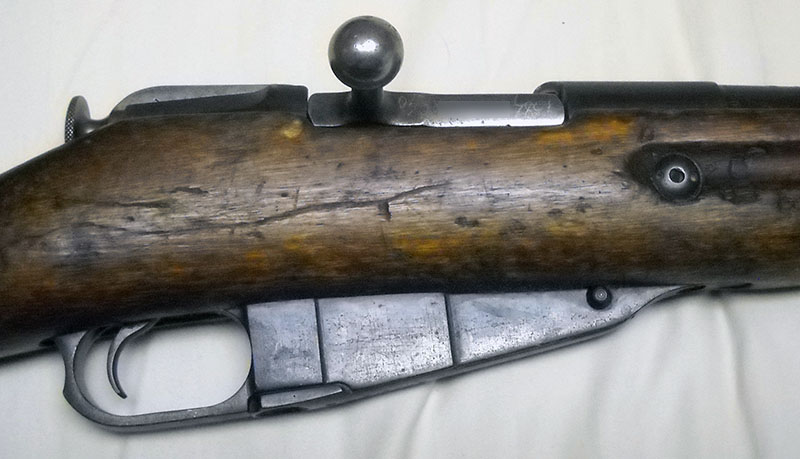
Here is the right side of the action. I've blurred the serial number on the bolt, but I didn't really need to bother, because it's not the same as the actual gun's serial number. This is not uncommon with old military arms; that is, after all, why the parts were designed to be interchangeable. Anyway, as you see, it's a pretty simple, robust design: straight bolt handle, no switches or fiddling bits cluttering it up. Easy to manufacture, easy to maintain. (Sniper variants had a downward bend in the bolt handle so that the operator's hand wouldn't bang into the scope, which is considerate.)
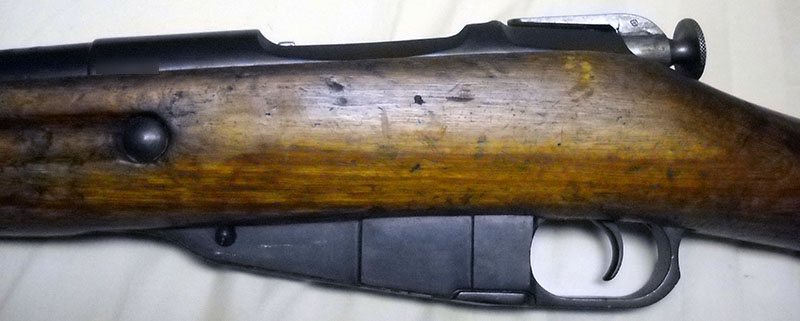
Here's the left side. As is often the case with right-handed bolt-action rifles, not a lot to see over here. Note that there is no obvious safety control. We'll get back to that.
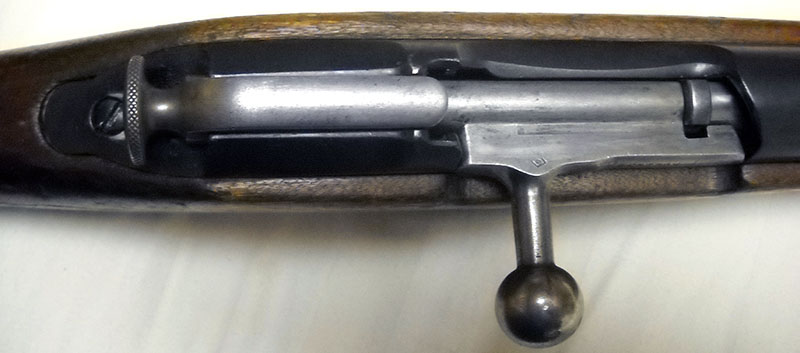
Top view. Note the proof mark at the base of the bolt handle.

From the top, with the bolt open, you can see the magazine follower, and the clip guide slot is more obvious. This rifle was originally designed to be loaded one round at a time by hand, and the stripper clip system was added during the revisions (another thing they swiped from Nagant, as it happens). Because of this, it is still quite easy (if time-consuming) to load by hand—much easier, in my experience, than the Lee-Enfield, which really wants to be stripper-charged if you're not going to take the magazine out of the rifle. (The latter was, as we saw, how it was meant to be loaded.)

That's not an option with the Mosin-Nagant, because you can't take the magazine out of it. It looks like it might be a detachable magazine, but it isn't. That latch you see there isn't a magazine release, it just unlocks the bottom plate, which is hinged at the front:
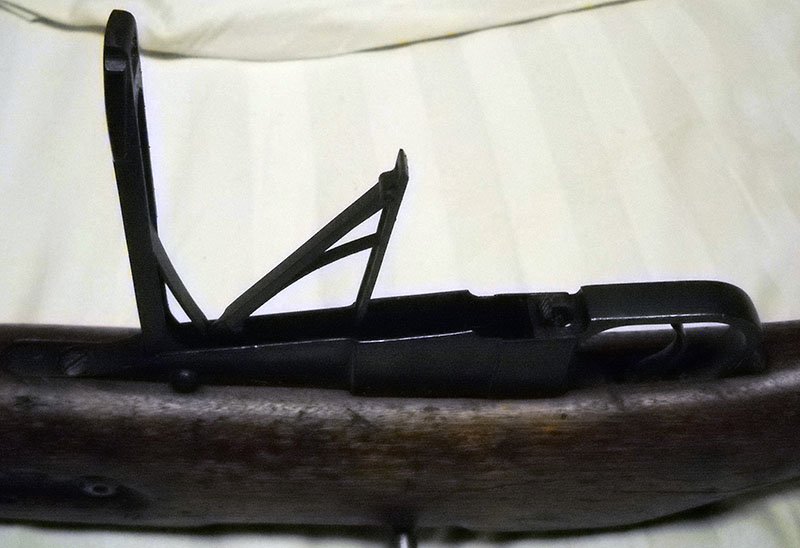
This makes it possible to clean the inside of the magazine, which would otherwise be a royal pain. (I suppose if you had reason to believe you had a bad batch of ammunition, this would also make it easy to dump out the whole magazine at once.) Note that the follower spring is attached to the base plate; that's another feature they swiped from Nagant. In the original it was just sort of in there, and so if you opened the magazine like this it would fall out and probably get lost. Magazine capacity is five rounds, which was pretty standard for the day.
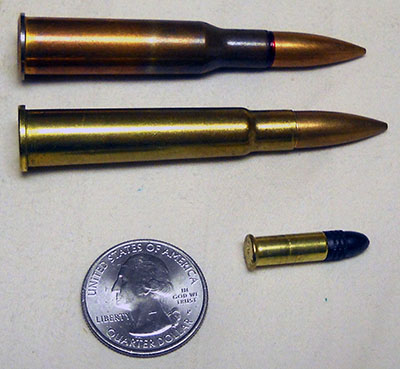
For comparison, here is a 7.62×54mmR round (top) with a .303 British round, a .22 Long Rifle rimfire cartridge, and a U.S. quarter dollar for scale. The Russian cartridge is slightly shorter but rather bigger around than the British one, bullets approximately the same, comparable ballistics. Sadly, I don't have any Mosin-Nagant stripper clips, so I can't duplicate the "here's what it looks like to load it" shot from the SMLE writeup, but it's a broadly similar system.
Like .303 British, the 7.62×54mmR cartridge is fairly punishing to shoot, and like the SMLE, the Mosin-Nagant M44 makes no particular effort to help the shooter out with that. This is what the butt end of the stock looks like:
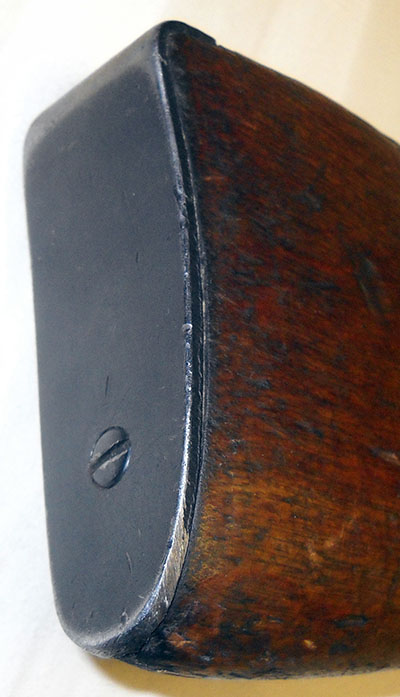
Note that millimeter or two of soft, comforting steel plate. Thanks, guys. I suppose it does make for a more robust field expedient door-smasher-downer, which was probably more important to the designers at the time.
In keeping with its simple, easily-field-repaired design, the Mosin-Nagant has about the simplest bolt release system imaginable. What you do is open the bolt, then depress the trigger (it can't fire because the bolt is fully open), at which point you can just pull the bolt right off the back.
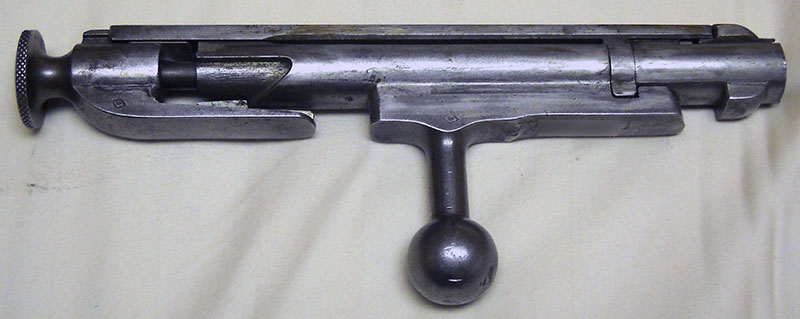
The bolt can be disassembled further from this point (in case you need to, for example, replace the bolt head, firing pin, or extractor), but I'm not going to do that; there are some pretty stiff springs in there and it's a hassle. While we're here, though, we can take a look at the bolt face.
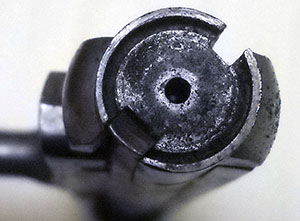
There's the business end. Note the hole in the middle for the firing pin (which is retracted right now, and so not visible). The extractor is at the 7 o'clock position; it pops over the rim on the cartridge when the bolt goes fully into battery, so that when the bolt is opened again, the empty is dragged out of the chamber. At the end of the bolt's travel, an ejector built into the rifle's body kicks the empty out, so the bolt is free to pick up one (and only one, thanks to Nagant's interrupter) round and chamber it on the forward stroke.
You will note the pitting and discoloration on the bolt face. This is a consequence of the fact that so much Soviet surplus 7.62x54mmR ammunition is fitted with primers that leave a corrosive residue, and previous owners have not been really scrupulous about cleaning the bolt after shooting said ammunition. It looks nasty, but the damage in this case is only cosmetic, and thanks to the modular design of the bolt, if I really had to I could replace the bolt head for about $30 without having to toss out the rest of it.
Note here for those who remember the SMLE entry: the Nagant action cocks on closing, not opening, meaning the closing stroke takes noticeably more work than the opening. Whether it's cocked can be seen from the position of the knurled cocking knob at the back of the bolt. Here it is cocked:
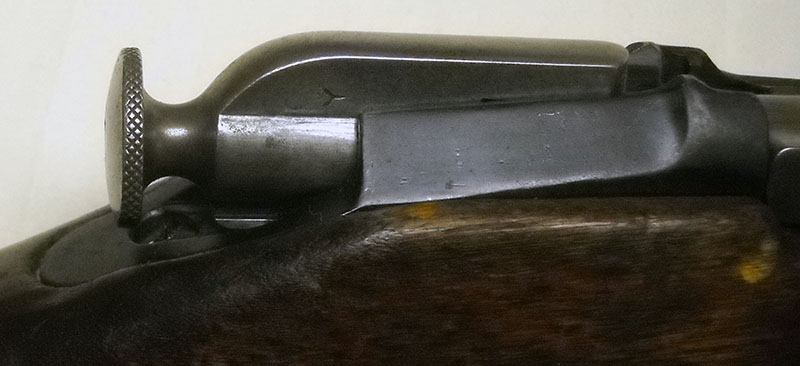
And this is how far forward it goes when fired.
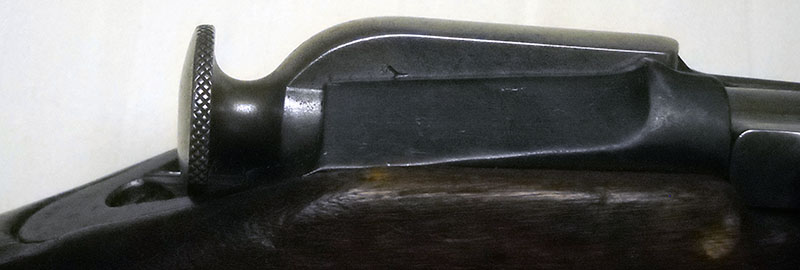
(Note the relative position of the knob vs. the tang screw underneath it.)
The cocking knob is also there so that, as on the Lee-Enfield action, if you get a dud cartridge and want to hit it again before cycling it out and moving on to the next one, you can just pull that back and go again. However, on the Mosin-Nagant it has another trick: it's also the safety.
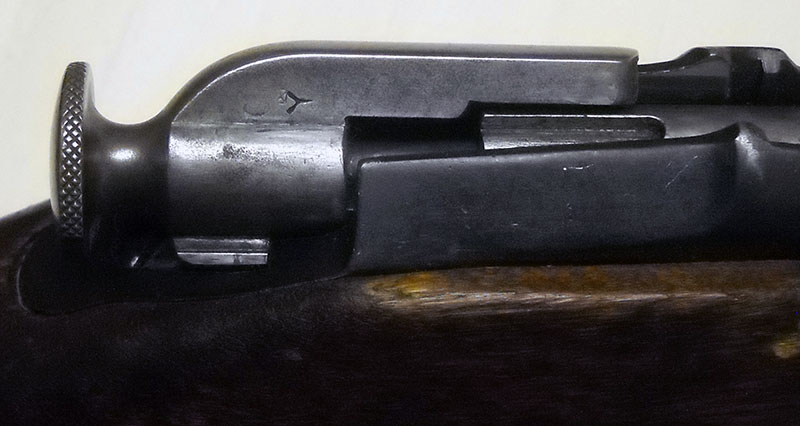
As you see above, to set the safety on a Mosin-Nagant, you have to muckle onto the cocking knob, drag it a little farther back, and then turn it a little way counterclockwise (as seen from the back of the rifle). Unlike most other features of the Mosin-Nagant's operation (with the arguable exception of the bolt release), this is not very intuitive. At least I wouldn't have figured it out myself just from frigging around with the rifle for a while. It's an odd departure in what is otherwise a mindfully conscript-proof design. Then again, safeties weren't considered overwhelmingly important in military rifles at the time. On a road march, for instance, the usual procedure was to just not load them, which solves the problem pretty handily.
(It's also really hard, because the Mosin-Nagant's striker spring, which you have to overcome to do that, is extremely robust, and that narrow little knob does not offer the best grip. A longer, multi-knurled affair like the one on the Nambu pistol—which, ironically, really doesn't need a cocking knob that beefy—would help a lot, I think.)
Like virtually all infantry rifles of its time, the Model 1944 has a tangent rear sight.
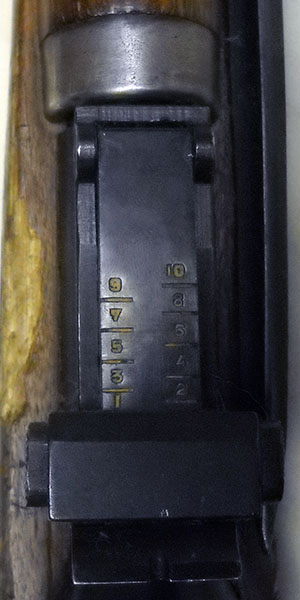
Not quite as ambitious as the SMLE's, but 1000 meters² is still pretty optimistic for a carbine.
A closer look at that integral bayonet:

(That metal-edged slot you see in the forestock is one of the hardpoints for attaching a sling; the other is on the buttstock and will be evident in another photo later on.)
The bayonet is secured in the folded position by a spring mechanism, which is operated by sliding the muzzle ring, which is affixed to a spring-loaded sleeve. You can get a better look at that in this shot of the bayonet halfway deployed:
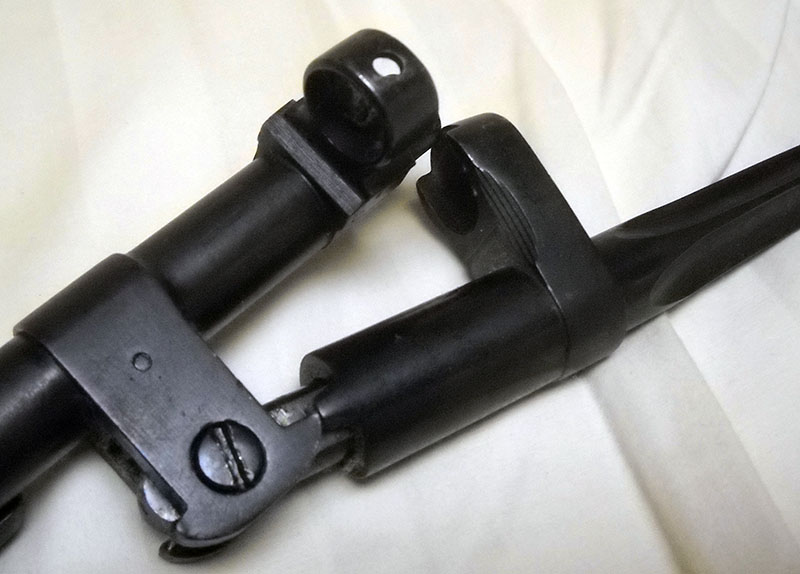
Note the bevel on the muzzle ring, which ensures that once you've unlocked the bayonet and started swinging it forward, you don't actually have to hold the catch forward against its spring to lock it. (You can also get a good look at one of the grooved finger depressions thoughtfully provided to make it easier to operate the catch.)

Here it is in its fixed position, ready for action. The M44's bayonet is a cruciform spike, its edges are not sharpened. It's only for sticking into things. Hitlerite bandits, presumably. To unlock, push the muzzle ring forward using the same finger grooves and pivot it back until it locks into its groove in the stock. (I would be reluctant to do this when the rifle is loaded, since that means putting your fingers right out by the muzzle.) This shot also provides a good view of the front sight, which is a simple post shrouded by a ring (which serves the same function as the flanges on an SMLE's muzzle, protecting the post from getting bent if the rifle is dropped or banged around).
Markings on this particular variant are quite simple, presumably owing to the fact that it was developed as a wartime expedient.
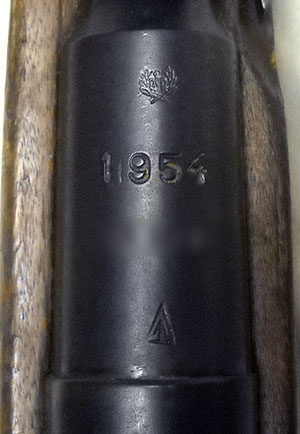
I'm not sure of the significance of the "1954" there; most of my sources agree that the Model 1944 was only produced until 1948. It might mean it was refurbished in 1954, or, given that it doesn't include the usual ? (Cyrillic g, short for ???, "year"), it might not mean the year 1954 at all. Above it is either a proof or army acceptance mark; below is the serial number (redacted) and the arrow-in-triangle emblem of the Izhevsk arsenal (which you may remember is also on my Nagant revolver). And that, a bit disappointingly, is it, except for repetitions of the serial number in various places. No caliber marking, because the Red Army only used one standard-issue rifle round in 1944 and it wasn't considered necessary. Note also that this rifle has no U.S. federal import markings, which indicates that it entered the country before 1968 (assuming it did so legally).
Well, that's not quite true, it also has this mark on the stock:
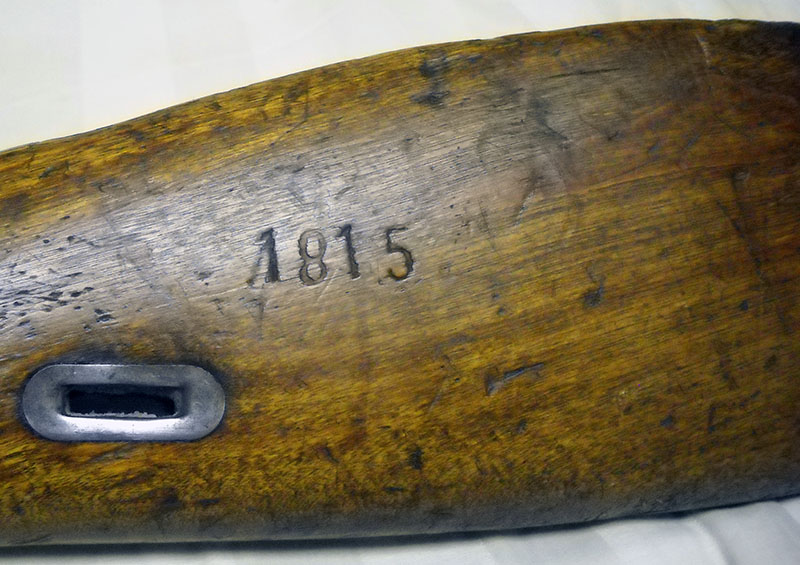
I have no idea what this signifies; obviously not the year. I'm guessing it's some sort of logistics marking, indicating a unit the rifle was issued to, or a particular stockpile it was placed in, or the like. (Also visible in this photo is the rear sling hardpoint.)
After this model, there was basically just one more revision of the Mosin-Nagant, at least in Russian/Soviet service: the Model 1891/59, which was basically a 91/30 cut down to carbine length. By that point, though, the bolt-action rifle had finally been replaced in front-line Soviet service, first by the semiautomatic SKS, then by the AK-47 and its successors. As previously noted, Mosin-Nagants of various kinds (and clones of same produced by other Eastern Bloc states, and—inevitably—Chinese knockoffs of those) continued to serve in non-front-line capacities long after. In some instances, they still do; there were and are various sniper variants and whatnot kicking around, some official, some one-off field modifications, and Mosin-Nagant actions fitted out as sniper rifles are still in use in some countries' armed forces.
Oh yes—and then there was the obrez, which was possibly the most ill-advised firearm ever devised by the mind of man. The obrez was never a standardized item and never produced by any arsenal; what they were, basically, were Model 1891 rifles stolen from the Imperial Army and cut down into big ol' pistols by various revolutionaries, criminals, and other irregulars in the crazy dying days of the Tsar's empire, before said revolutionaries et cetera had managed to sack some arsenals and get ahold of proper handguns. Seriously. A full-power bolt-action military rifle with the stock cut off until just a hand's worth was left and the barrel sawn down to anywhere from four to eight inches. The 7.62×54mmR cartridge is unpleasant enough to shoot from a full-stocked, full-length, full-weight rifle. I can only imagine how... memorable... an obrez must've been to employ.
(This was, as Ian over at Forgotten Weapons points out, not a practice limited to Russia, nor to the Mosin-Nagant, but it seems to have originated with them, and today Mosin obrez are the best-known versions. (Dig Ian's understatement there, by the way. "Recoil is pretty hefty." I suspect that's a little like saying the Death Star was "formidable". :)
Here's another interesting off-label use: the Finns got hold of loads of Mosin-Nagants during the Winter War and the Continuation War, either by capturing them from Soviet troops or by buying them from other countries (the US, as noted in a previous episode, had loads of the things owing to a production deal for the Tsar that went south when the Bolsheviks took over). What they evidently didn't have was a lot of Soviet ammunition for them, so they rechambered theirs into 7.62×53mmR. That's right, a cartridge with a case one millimeter shorter. The other funny thing is that the captured ones generally came out of the Finnish arsenals that reworked them in much better condition than they went in, because, you know... Finland. Theirs is among the armies that are still using the dang things as sniper rifles, because if it ain't broke...
There is, alas, no particular personal story behind mine, except that it's an example of an unregretted impulse purchase. I bought it circa 2003, shortly after I started working at the Katahdin Times, which was the first steady job I'd had since the tech bubble burst and I moved back to Maine. I didn't get paid a lot in that job, but just getting paid at all was like a new experience by that point, and besides, one thing about Mosin-Nagants is that they're cheap. Really cheap. I paid $85 for this one, and there's nothing wrong with it. It's not in great shape cosmetically, but mechanically it's perfectly fine, and the bore is in excellent condition (so evidently whoever didn't clean up the bolt after the corrosive ammo paid a little more attention to the bore). It shoots very well and will presumably outlast me by decades (assuming such things remain legal that long).
They're not that cheap any more, but virtually any gun shop in the United States will probably still have one or two rattling around for less than $200—particularly here in the Northeast, where they seem still to be popular as starter deer rifles.
Next week: not sure yet. I have something in mind, but there might be a surprise.
--G.
Addendum, originally posted January 12, 2016
Got some new photos to go along with this entry.
First off, I bought a cleaning rod, as you will note in the original photos that my carbine didn't have one.
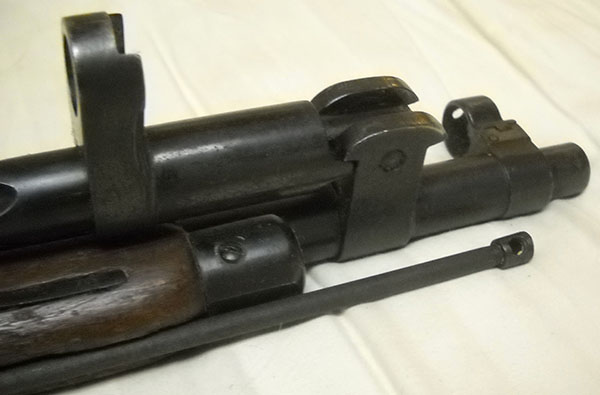
Note that I have a set of brass universal cleaning rods for actual cleaning (which can't damage the bore, unlike a steel one); this is just for the sake of completeness.
Also, I got my hands on a few Mosin-Nagant stripper clips!
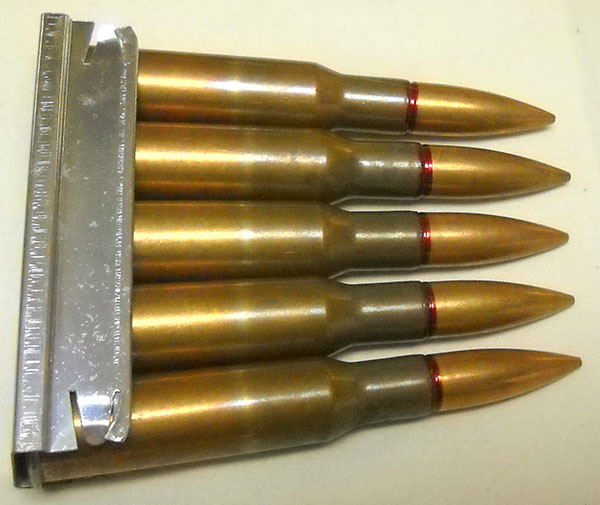
For the record, because I had someone accuse me of this once at the range, the red stripe on these 7.62×54mmR cartridges doesn't have any special meaning. They're just old Russian surplus metal-jacketed rounds. It does not mean they have armor-piercing bullets (which is a faux pas at an indoor shooting range, for obvious reasons).
Here's that clip in action, very similar to the way it works in the Lee-Enfield and, indeed, pretty much any other bolt-action rifle that is so configured.
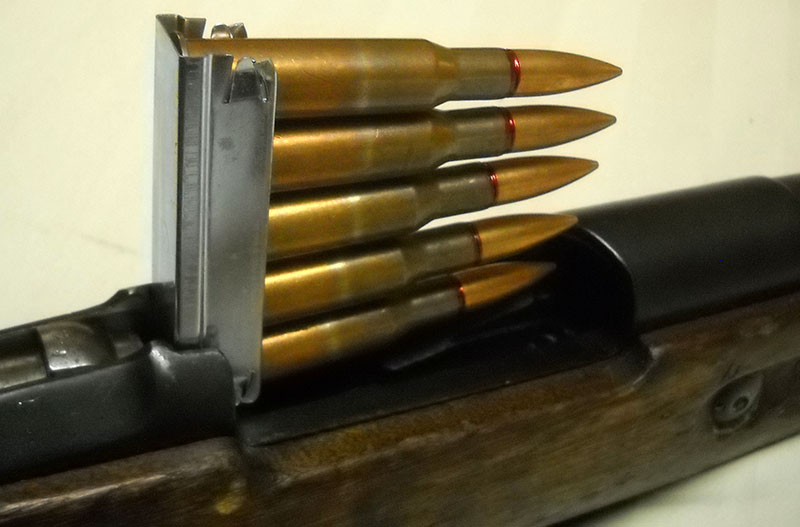
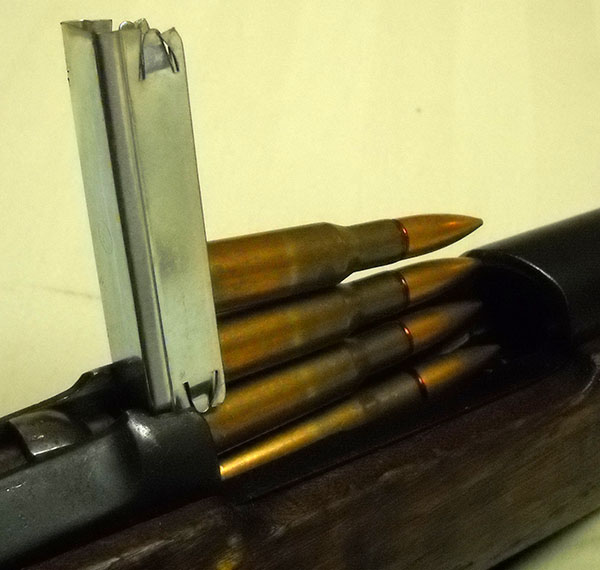
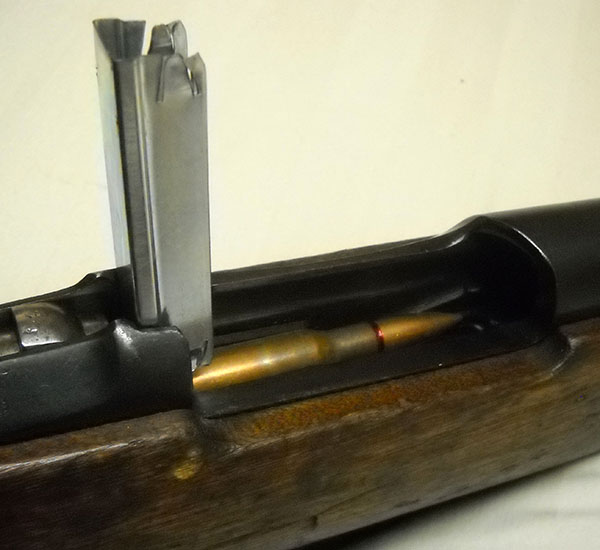
I went ahead and actually loaded the rifle this time because of the ease with which the Mosin-Nagant can be unloaded.
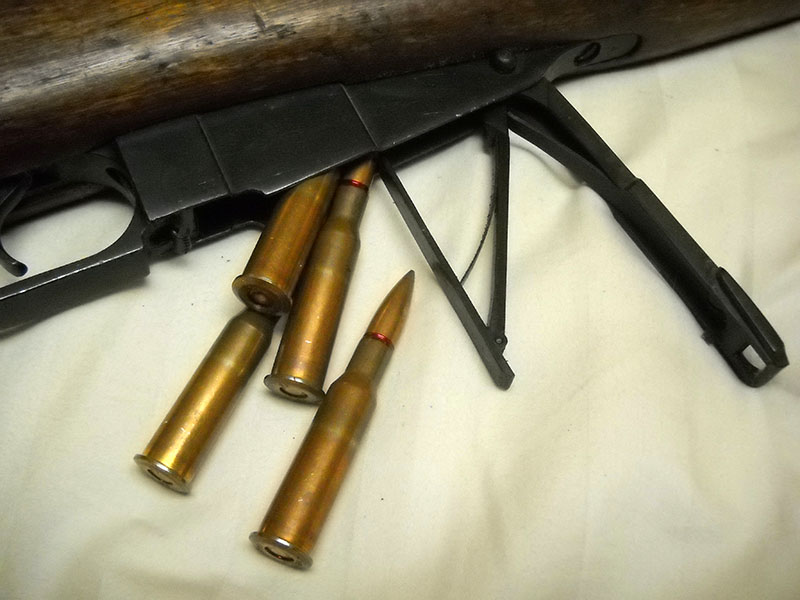
Never closed the bolt, never chambered a round, never endangered the neighbors. :)
--G.
¹ Presumably not Grigoriy Zinoviev, the Bolshevik leader who stood with Trotsky against Stalin in the power scramble after Lenin's death and was therefore shot in 1936. He was only six when the rifle trials started, and Zinoviev wasn't his real name anyway. None of those guys became famous under his real name. It was a Bolshevik thing, even after they were in power and didn't actually need aliases any more; though in Zinoviev's case that was at least partly because his real name was Hirsch Apfelbaum and Russia was not a great place to be a Jew, before or after the revolution. But I digress.
² Pre-Soviet Mosin-Nagants' sights were actually calibrated in paces, which is a fairly handy unit of measure for the use of poorly educated conscripts like the majority of the Tsar's soldiers.